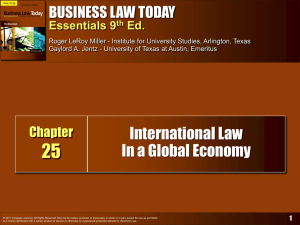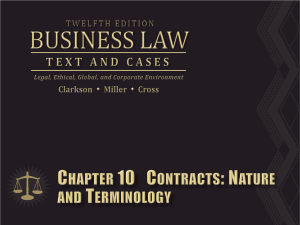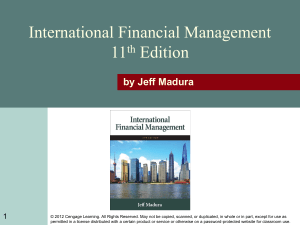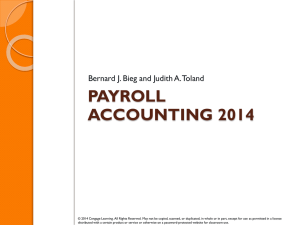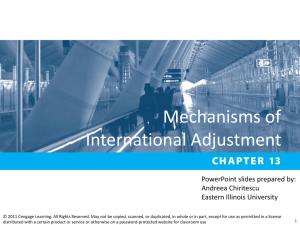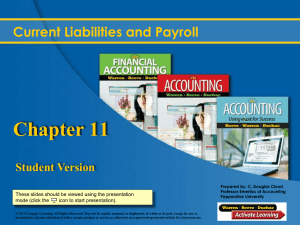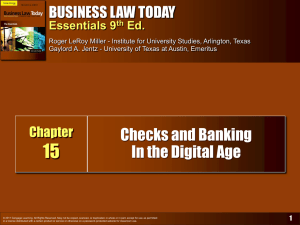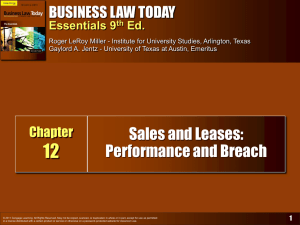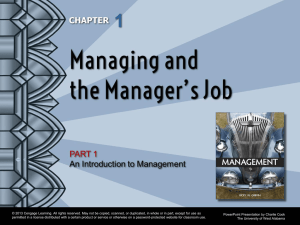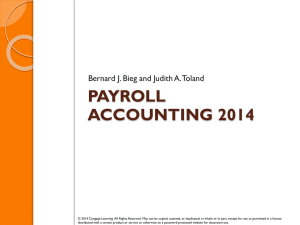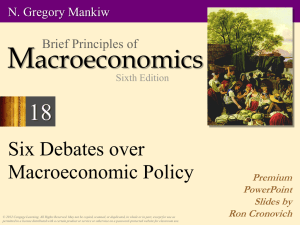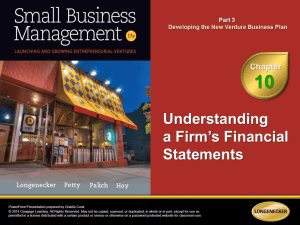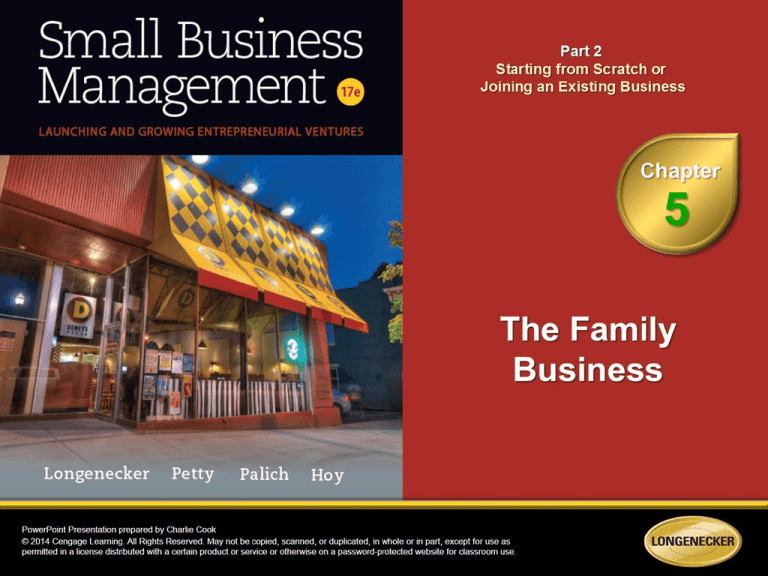
1. Explain the forces that can keep a family
business moving forward.
2. Describe the complex roles and relationships
involved in a family business.
3. Identify management practices that enable a
family business to function effectively.
4. Describe the process of managerial succession in
a family business
© 2014 Cengage Learning. All Rights Reserved. May not be copied, scanned, or duplicated, in whole or in part, except for use as
permitted in a license distributed with a certain product or service or otherwise on a password-protected website for classroom use.
5–2
What Is a Family?
• Family
A group of people bound by a shared history and a
commitment to share a future together, while
supporting the development and well-being of
individual members.
Nuclear
Extended
Blended
© 2014 Cengage Learning. All Rights Reserved. May not be copied, scanned, or duplicated, in whole or in part, except for use as
permitted in a license distributed with a certain product or service or otherwise on a password-protected website for classroom use.
5–3
What Is a Family Business?
• Family Business
An organization in which either the individuals who
established or acquired the firm, or their descendants,
significantly influence the strategic decisions and life
course of the firm.
• Types of Family Businesses
Owner-managed business
Sibling partnership
Smith Family Hardware
Est. 1935
Cousin consortium
Welcome
© 2014 Cengage Learning. All Rights Reserved. May not be copied, scanned, or duplicated, in whole or in part, except for use as
permitted in a license distributed with a certain product or service or otherwise on a password-protected website for classroom use.
5–4
5.1
The Three-Circle Model of Family Firms
© 2014 Cengage Learning. All Rights Reserved. May not be copied, scanned, or duplicated, in whole or in part, except for use as
permitted in a license distributed with a certain product or service or otherwise on a password-protected website for classroom use.
5–5
Family and Business Overlap
• Family Concerns
• Business Concerns
Care and nurturing of
Production and
family members
Employment and
advancement in the
firm
Loyalty to the family
distribution of goods
and/or services
Need for professional
management
Effective and efficient
operation of the firm
© 2014 Cengage Learning. All Rights Reserved. May not be copied, scanned, or duplicated, in whole or in part, except for use as
permitted in a license distributed with a certain product or service or otherwise on a password-protected website for classroom use.
5–6
Advantages of a Family Business
• Strength of family relationships during
challenging periods of business change
• Financial sacrifices that family members make
for the good of the firm
• Operation as a family business distinguishes the
firm from its competitors
• Higher levels of concern for its community and
non-family employees
• Capability to plan and prepare for the long haul
• Emphasis on quality and value
© 2014 Cengage Learning. All Rights Reserved. May not be copied, scanned, or duplicated, in whole or in part, except for use as
permitted in a license distributed with a certain product or service or otherwise on a password-protected website for classroom use.
5–7
5.2
Advantages of a Family Business
Positives (+)
Negatives (–)
Trust among family members
Mistrust by nonfamily employees
of incompetent family employees
Loyalty to the family
Lack of loyalty to the firm
Commitment
Entitlement
Knowledge
Lack of knowledge
Long-range thinking
Demand for instant gratification
Close communication
Failure to communicate
© 2014 Cengage Learning. All Rights Reserved. May not be copied, scanned, or duplicated, in whole or in part, except for use as
permitted in a license distributed with a certain product or service or otherwise on a password-protected website for classroom use.
5–8
Advantages of a Family Business
© 2014 Cengage Learning. All Rights Reserved. May not be copied, scanned, or duplicated, in whole or in part, except for use as
permitted in a license distributed with a certain product or service or otherwise on a password-protected website for classroom use.
5–9
Disadvantages of a Family Business
• Conflict among family members about:
Risk (consequences of failure) to the family in
launching a business
Nepotism and the differences in competencies and
merit of family members involved in the business
Family traditions versus the business need to
innovate and seize opportunities
Unity and cooperation of family versus business need
to foster diversity and competition
Family loyalty versus the necessity to provide
opportunities for non-family employees
© 2014 Cengage Learning. All Rights Reserved. May not be copied, scanned, or duplicated, in whole or in part, except for use as
permitted in a license distributed with a certain product or service or otherwise on a password-protected website for classroom use.
5–10
Dynamic Family Businesses
• The Founder’s Imprint on the Culture
The founder’s core values become a transmitted part
of the culture (for better or worse).
• Family Business’ Organizational Culture
Cultural Values
Mutual respect
Integrity
Wise use of resources
Personal responsibility
“Fun”
© 2014 Cengage Learning. All Rights Reserved. May not be copied, scanned, or duplicated, in whole or in part, except for use as
permitted in a license distributed with a certain product or service or otherwise on a password-protected website for classroom use.
5–11
The Commitment of Family Members
• Socioemotional Wealth
Nonfinancial factors in a
family firm that affect the
commitment of family
members to the business.
© 2014 Cengage Learning. All Rights Reserved. May not be copied, scanned, or duplicated, in whole or in part, except for use as
permitted in a license distributed with a certain product or service or otherwise on a password-protected website for classroom use.
5–12
5.3
Dimensions in Socioemotional Commitment
Family control and influence.
Specifically, family members exert control over strategic decisions.
Identification of family members with the firm.
The firm may be seen as an extension of the family itself.
Binding social ties.
Family members feel closeness and solidarity.
Emotional attachment of family members.
The history and knowledge of past events influence and shape
current activities.
Renewal of family bonds to the firm through dynastic succession.
There is an intention to hand the business down to future
generations.
© 2014 Cengage Learning. All Rights Reserved. May not be copied, scanned, or duplicated, in whole or in part, except for use as
permitted in a license distributed with a certain product or service or otherwise on a password-protected website for classroom use.
5–13
The Fear of Commitment
1. Fear of failure.
If I really take ownership of my life, I might fail.
2. Fear of success.
If I succeed, others will expect more of me in the future.
3. Fear of commitment.
If I never really try, then I will never really fail.
4. Fear of disappointing parents.
It would break their hearts if I worked for another firm
instead of the family business.
5. Fear of disappointing others.
If I don’t follow my friends, I might lose their friendship.
© 2014 Cengage Learning. All Rights Reserved. May not be copied, scanned, or duplicated, in whole or in part, except for use as
permitted in a license distributed with a certain product or service or otherwise on a password-protected website for classroom use.
5–14
Commitment Through Unity
• Family Unity
Is the oneness of mind, feeling, and action among
family members.
Is critical to family business success.
Is reflected in the feelings of family members being
completely or very unified as an ownership group.
Is significantly associated with the firm’s past growth
and expectations for its future growth.
Makes owner families more likely to share their
values with customers and employees.
© 2014 Cengage Learning. All Rights Reserved. May not be copied, scanned, or duplicated, in whole or in part, except for use as
permitted in a license distributed with a certain product or service or otherwise on a password-protected website for classroom use.
5–15
Family Roles and Relationships
• Co-Preneurs (Husband–Wife Teams)
Opportunity to share more in each other’s lives
Business differences interfere with family life
Work doesn’t leave time for family life
Sharing family responsibilities eases the load
• Sons and Daughters
Personal preferences different from the business
Personal qualifications insufficient to assume role in
business
Desire for personal freedom to choose another career
© 2014 Cengage Learning. All Rights Reserved. May not be copied, scanned, or duplicated, in whole or in part, except for use as
permitted in a license distributed with a certain product or service or otherwise on a password-protected website for classroom use.
5–16
Family Roles and Relationships (cont’d)
• Parental Concerns in Passing the Business On:
Does my child possess the temperament and ability
necessary for business leadership?
How do I motivate my child’s interest in the business?
What type of education and expertise will be most helpful
in preparing my child for leadership?
What timetable should I follow with my child?
How can I avoid favoritism in managing and developing
my child for a leadership role?
Is sibling rivalry a problem, and can it be avoided?
How can I prevent the business relationship from
damaging or destroying the parent–child relationship?
© 2014 Cengage Learning. All Rights Reserved. May not be copied, scanned, or duplicated, in whole or in part, except for use as
permitted in a license distributed with a certain product or service or otherwise on a password-protected website for classroom use.
5–17
Family Roles and Relationships (cont’d)
• Sibling Cooperation, Sibling Rivalry
Best case: siblings work as a team, each contributing
services according to his or her abilities.
Worst case: siblings compete as rivals and disagree
about their business roles.
Predator/parasite conflict
Outsiders view family members working for the firm as
predators taking advantage of their family position.
Insiders view outsiders as parasites
making claims on the business
without contributing to its success.
© 2014 Cengage Learning. All Rights Reserved. May not be copied, scanned, or duplicated, in whole or in part, except for use as
permitted in a license distributed with a certain product or service or otherwise on a password-protected website for classroom use.
5–18
Family Roles and Relationships (cont’d)
• In-laws In and Out of the Business
Disagreements about how to treat and reward
in-laws and family members/children
Assign to different branches or
to different business roles
• The Entrepreneur’s Spouse
Communication between
entrepreneur and spouse is
critical for their performance
as an effective team for both
the business and the family.
© 2014 Cengage Learning. All Rights Reserved. May not be copied, scanned, or duplicated, in whole or in part, except for use as
permitted in a license distributed with a certain product or service or otherwise on a password-protected website for classroom use.
5–19
Best Practices for Family Businesses
• Promote learning to stimulate new thinking and fresh strategic
insights.
• Solicit ample input from outsiders to keep things in perspective.
• Establish channels for constructive communication and use them
often.
• Build a culture that accepts continuous change.
• Promote family members only according to their skill levels.
• Attract and retain excellent nonfamily managers.
• Ensure fair compensation for all employees, including those outside
the family.
• Establish a solid leadership succession plan.
• Exploit the unique advantages of family ownership.
© 2014 Cengage Learning. All Rights Reserved. May not be copied, scanned, or duplicated, in whole or in part, except for use as
permitted in a license distributed with a certain product or service or otherwise on a password-protected website for classroom use.
5–20
Bringing Nonfamily Members into the Firm
To bridge the
gap between
generations
To set a new
direction for
the firm
Reasons for
Nonmembers
in the Firm
To provide
new skills and
expertise
To deal with
change
© 2014 Cengage Learning. All Rights Reserved. May not be copied, scanned, or duplicated, in whole or in part, except for use as
permitted in a license distributed with a certain product or service or otherwise on a password-protected website for classroom use.
1–21
Good Governance in the Family Firm
• Nonfamily Employees in a Family Firm
Hazards:
Competition with family members for advancement
Getting caught in the crossfire and politics of family
competition within the firm
Solutions:
Identify family-only reserved positions in advance.
Treat both family and nonfamily employees fairly in matters of
reward and promotion.
© 2014 Cengage Learning. All Rights Reserved. May not be copied, scanned, or duplicated, in whole or in part, except for use as
permitted in a license distributed with a certain product or service or otherwise on a password-protected website for classroom use.
5–22
Governance in the Family Firm (cont’d)
• Family Retreats
A gathering of family
members, usually
away from the firm,
to discuss family
business matters.
Use of an outside
facilitator may be
necessary.
• Guidelines
Be clear about the purpose
of the retreat.
Set small, attainable goals.
Use an agenda and stick to it.
Give everyone a chance to
participate.
Know the difference between
consensus and agreement.
© 2014 Cengage Learning. All Rights Reserved. May not be copied, scanned, or duplicated, in whole or in part, except for use as
permitted in a license distributed with a certain product or service or otherwise on a password-protected website for classroom use.
5–23
Governance in the Family Firm (cont’d)
• Family Councils
An organized group of family members who gather
periodically to discuss family-related business issues.
Represent the family to board of directors
Useful in developing family harmony
Increases understanding of family
traditions and interest
© 2014 Cengage Learning. All Rights Reserved. May not be copied, scanned, or duplicated, in whole or in part, except for use as
permitted in a license distributed with a certain product or service or otherwise on a password-protected website for classroom use.
5–24
Good Governance in the Family Firm
(cont’d)
• Family Business Constitution
A statement of principles intended to guide a family
firm through times of crisis and change.
The core values that all family members should follow
A process for decision making
Benefits that family members may receive from the business
A mechanism for introducing younger members to the family
business and its governance structures
A dispute resolution procedure
The philanthropic ambitions of the family
© 2014 Cengage Learning. All Rights Reserved. May not be copied, scanned, or duplicated, in whole or in part, except for use as
permitted in a license distributed with a certain product or service or otherwise on a password-protected website for classroom use.
5–25
The Process of Leadership Succession
• Available Family Talent
Mentoring
Guiding and supporting the work
and development of a new or lessexperienced organization member.
Competency
Allowing only qualified competent
family members to assume leadership
roles in the firm increases the value of
the firm for all who have an ownership
interest in it.
© 2014 Cengage Learning. All Rights Reserved. May not be copied, scanned, or duplicated, in whole or in part, except for use as
permitted in a license distributed with a certain product or service or otherwise on a password-protected website for classroom use.
5–26
Preparing for Succession
• Responsibilities of the
Senior Generation
• Responsibilities of the
Junior Generation
Communication
Be open to
Planning
communication
Develop a personal
action plan
Implement the
personal action plan
Prepare for ownership
Design life plans
Accountability
Owner development
Long-term planning
© 2014 Cengage Learning. All Rights Reserved. May not be copied, scanned, or duplicated, in whole or in part, except for use as
permitted in a license distributed with a certain product or service or otherwise on a password-protected website for classroom use.
5–27
Conditions Favoring Successful Leadership
Succession in a Family Firm
• A sound, profitable business
• Stable, healthy family relationships
• Advance planning for leadership succession
• Positive family leadership and a team-oriented
management structure
• Presentation of career opportunities without
pressure
• Open communication on family business issues
© 2014 Cengage Learning. All Rights Reserved. May not be copied, scanned, or duplicated, in whole or in part, except for use as
permitted in a license distributed with a certain product or service or otherwise on a password-protected website for classroom use.
5–28
Reluctant Parents and
Ambitious Children
• Transfer of Ownership
Passing ownership of a family business to the next
generation involves deciding:
Who will inherit the family firm? When?
Should each heir receive an equal share?
Should ownership be transferred gradually?
How are tax considerations to be handled?
What to do with other wealth and assets of the founding
entrepreneur?
© 2014 Cengage Learning. All Rights Reserved. May not be copied, scanned, or duplicated, in whole or in part, except for use as
permitted in a license distributed with a certain product or service or otherwise on a password-protected website for classroom use.
5–29
Key Terms
co-preneurs
cousin consortium
family
family business
family business constitution
family council
family retreat
mentoring
nepotism
organizational culture
owner-managed business
sibling partnership
socioemotional wealth
transfer of ownership
© 2014 Cengage Learning. All Rights Reserved. May not be copied, scanned, or duplicated, in whole or in part, except for use as
permitted in a license distributed with a certain product or service or otherwise on a password-protected website for classroom use.
5–30

